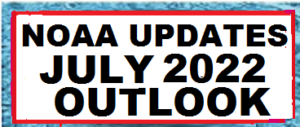NOAA Updates its ENSO Analysis on September 8, 2022 – La Nina will probably end soon.
On the second Thursday of every month, NOAA issues its analysis of the status of ENSO. This includes determining the Alert System Status. Although the current status remains the same i.e. La Nina Advisory, the forecast has been adjusted slightly from last month. The IRI analysis suggests it could be slightly later than it appeared last month. Also, the probability that it will extend into the winter is much higher. So what I anticipated as being a three-peat looks to be a reality. But in theory, things could change.
Nevertheless, that is what both NOAA and I think will happen. But it could happen a bit earlier or a bit later.
I provided a small sample of model runs by a number of different meteorological agencies that is presented by the Australian Bureau of Meteorology (BOM) and they suggest that maybe we will be in ENSO Neutral in January or February rather than March as NOAA seems to be thinking. NOAA is placing more weight on the statistical rather than dynamic models but statistics requires data and there have not been a lot of similar situations but what data there is suggests March is more likely than January or February. But perhaps this La Nina will continue beyond March. Maybe it will continue for a fourth year.






